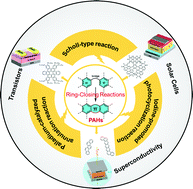Polycyclic aromatic hydrocarbon-based organic semiconductors: ring-closing synthesis and optoelectronic properties†
Abstract
Polycyclic aromatic hydrocarbons (PAHs) as a typical class of organic semiconductors demonstrate unique optical, electrical, magnetic and other interesting properties due to their extended conjugation and diverse structures. Ring-closing reactions are very significant for the synthesis of PAHs with various structures and optoelectronic properties, which endow them great potential for applications in organic electronics. The aim of this article is to present a concise summary on the recent advances on the ring-closing reactions for the synthesis of organic semiconductors, with a discussion on their applicable conditions, followed by their attractive applications in organic field-effect transistors (especially chiral transistors and biradicaloid-based transistors), organic solar cells, etc. Finally, a short conclusion and perspective are given on the further development of new ring-closing reactions toward novel PAH materials with promising applications.

- This article is part of the themed collection: Special issue in honour of Daoben Zhu


 Please wait while we load your content...
Please wait while we load your content...